Build a brand community that turns customers into lifelong advocates
Today’s customers are tired of endless ads, generic email blasts, and of feeling like everything is just a transaction.
That’s why brand communities have emerged as a powerful way for companies to build real relationships and connections with their customers. 73.6% of consumers said they’d purchase more frequently because of a brand community. When you cultivate a thriving community, you’re doing more than hosting conversations; you’re deepening engagement.
And that’s huge! As marketing channels become noisier and algorithms more unpredictable, brands need a way to cut through the noise. Companies are building communities on Circle that act as growth engines, driving higher customer spend and accelerating product adoption.
This is why we’re seeing thousands of brands, from early-stage startups to established companies, use brand communities to stand out and become the antidote to an increasingly AI-driven world. According to our 2025 Trends Report, the “overwhelming abundance of AI content and interactions is making authentic, human-led experiences that much more valuable.”
In this post, we’ll cover:
- What a brand community is (and how it differs from other communities)
- Why brand communities matter (and what makes for a great one)
- Tactics from the most successful brand communities
- Step-by-step guide on how to build your own brand community
What is a brand community?
A brand community is more than a collection of users or a fan base; it’s a purpose-driven network of customers, advocates, and champions who rally around shared values and the brand that embodies them. These communities aren’t just social spaces; they’re strategic ecosystems built to foster loyalty, drive value, and deepen emotional connection over time.
Unlike a Facebook group or one-off customer forum, a true brand community is:
- 🎯 Intentional: It’s designed with purpose and clarity. Every touchpoint, from onboarding to events to daily conversations, reinforces the community’s reason for existing. That reason ties directly to the brand’s mission.
- 💘 Reciprocal: A healthy brand community is a two-way street. Members gain connection, access, support, or a sense of identity. In return, the brand benefits from their insights, loyalty, advocacy, and product feedback. Everyone has a stake in the community’s success.
- ♾️ Ongoing: It’s not a flash-in-the-pan campaign or seasonal tactic. Brand communities are sustained over time through rituals, consistent engagement, and cultural norms. They become part of how your customers experience your brand, day in and day out.
At its core, a brand community is not “community for community’s sake.”
It’s a business asset: a structured, value-generating network rooted in shared identity and mutual benefit. It can lower acquisition costs, boost retention, increase customer lifetime value, and make your brand more resilient in moments of change or uncertainty.
HeyOrca cut acquisition costs 80% by building community first
When rising acquisition costs threatened growth in 2022, social media management platform HeyOrca (40K+ users) pivoted from paid acquisition to community building.
The results: 300% more impressions, 5,900% increase in post clicks, and an 80% drop in cost per acquisition. The strategy shift from transactions to relationships didn't just cut costs—it created a base of organic advocates who consistently promote the brand online.
Brand community vs. customer community
The terms "customer community" and "brand community" are often used interchangeably—but they’re not the same. Both involve bringing people together around your brand, but the purpose, emotional depth, and long-term impact are very different.
A customer community is a space where customers gather to learn, solve problems, and get the most out of your product. While these communities center around a product or service, they serve a clear purpose: support, education, and utility. People join because they’ve purchased something and want to make it work better for them.
Customer communities are solution-driven. They reduce support costs, accelerate onboarding, and give users a space to connect with others who share similar challenges or use cases. While they may foster some loyalty, the connection is usually functional, not overtly emotional.
These spaces are useful for:
- Sharing product updates or announcements
- Offering support and how-to content
- Enabling peer-to-peer troubleshooting
- Gathering product feedback
For example:
Canva Design Community (Facebook Groups): This is a large (450k!), moderated group where users ask design-related questions, report bugs, or share basic tips. While there's some peer-to-peer interaction, the focus is on product help and troubleshooting—not on fostering a deeper emotional connection with Canva’s mission.
A brand community goes further. It’s a strategic ecosystem where members rally around a shared identity, mission, or worldview. And the brand plays an active role in fostering belonging and collaboration. These communities create space not just for product talk, but for meaning, connection, and co-creation.
People don’t just show up to solve a problem; they stay because they belong. Brand communities deepen emotional connection, unlock organic advocacy, and help businesses grow through word-of-mouth, user-generated content, and engaged feedback loops.
These communities are ideal for:
- Deepening long-term engagement, advocacy, and trust
- Empowering members to co-create products, ideas, or experiences
- Driving business value through authentic, mission-aligned interaction
For example:
Notion’s Community (on Circle) shows how to amplify existing passion rather than create it from scratch. When users organically started creating templates and hosting meetups, Notion built infrastructure to support them: their Ambassador Program provides 300+ global advocates with event grants and early access, while their Template Gallery lets users solve each other's problems.
This decentralized approach—where community members lead and Notion provides resources—has generated near-daily user events worldwide and turned passionate users into certified consulting partners. The result: members don't just use the product, they actively build the ecosystem around it.
| Customer community | Brand community |
|---|---|
| Centered on product support or education | Centered on shared values, identity, or mission |
| Relationship is primarily transactional | Relationship is built on mutual value and belonging |
| Often exists to reduce support costs or increase adoption | Exists to foster loyalty, advocacy, and long-term growth |
| Members engage to solve problems or ask questions | Members engage to connect, solve problems, co-create, and contribute |
Customer communities and brand communities each offer distinct value—and many companies choose to blend them together to supercharge the impact. Either way, clearly defining your community’s purpose from the start is essential. It’s the foundation that shapes every decision, from strategy to structure.
Types of brand communities
Depending on your audience and goals, brand communities can take multiple forms. Each format comes with distinct advantages, and the best choice will depend on your capacity, your members' preferences, and the kind of experience you want to foster. Here are the formats you can take:
👩🏼💻 Fully online: Online communities are scalable, flexible, and accessible to members anywhere in the world. They’re especially well-suited for digital-native brands or audiences who prefer asynchronous engagement.
- Best for: Global audiences, busy professionals, brands prioritizing reach and low overhead.
🙋🏼♀️ Offline or in-person communities: In-person communities offer depth and intimacy that’s hard to replicate online. They create powerful shared experiences and a strong sense of belonging through face-to-face connection. Think local meetups, workshops, pop-up events, or branded retreats.
- Best for: Local or regional audiences, lifestyle brands, businesses rooted in physical presence or services.
🤳🏼 Hybrid: A hybrid model combines the reach of online with the emotional resonance of in-person. Many brands use digital platforms for everyday connection and supplement with in-person events like annual summits, chapter meetups, or live courses. While it requires more planning, a hybrid approach can create a vibrant, year-round community that deepens over time.
- Best for: Brands seeking a layered community that fosters different levels of engagement.
Choosing a format should align with your brand values, member preferences, and strategic goals.
Why do brand communities work so well?
Brand communities aren't just warm and fuzzy marketing tactics—they're revenue-driving engines that tap into fundamental human psychology. When done right, they create a powerful flywheel effect: the more your community connects, shares, and grows, the more business momentum you build.
This isn't just intuition; it's backed by decades of research into consumer behavior. The foundation was laid in 1998 when Susan Fournier reframed the entire concept of consumer-brand interactions, showing they function as genuine emotional relationships rather than simple transactions. These emotional ties became the key to understanding customer loyalty, word-of-mouth advocacy, and that crucial sense of belonging that keeps customers coming back.
Building on Fournier's work, Muniz and O’Guinn's landmark 2001 study identified the three pillars that make brand communities thrive:
- shared consciousness (members recognizing their connection to each other),
- rituals and traditions (the behaviors that bind the community together), and
- moral responsibility (members' commitment to helping each other and the brand).
These elements create communities that transcend mere commercial relationships—they become part of people's identities.
Fast forward to today, and consumer data confirms what researchers predicted decades ago.
- A 2024 SocialPlus consumer survey found that 68.7% of shoppers actively prefer buying from brands they can engage with through online communities.
- Meanwhile, the 2025 Acxiom CX Trends Report revealed that 86% of consumers say being part of a brand community shapes their entire brand experience.
The message is clear: brand communities have evolved from a "nice-to-have" to a business essential. They're increasingly central to how people connect with and stay loyal to brands, turning emotional connections into lasting customer relationships—and sustainable revenue.
The ROI of a brand community
A brand community nurtures loyalty, amplifies advocacy, and creates a feedback loop that fuels smarter decisions. From increasing retention to lowering acquisition costs, brand communities deliver measurable business value that outperforms many traditional channels.
Here’s what a healthy brand community fosters and the outcomes you can expect:
| What brand communities foster | ROI outcomes |
|---|---|
| Stronger loyalty and customer lifetime value | 🔁 Repeat purchases |
| Referral-driven growth + community support | 💰 Lower acquisition & support costs |
| Organic reputation-building and social proof | 🤝 Advocacy & increased referrals |
| Quick innovation driven by your most engaged users | 💡 Faster product feedback & adoption |
| First-party data and internal insights | 🧠 Strategic, smart growth |
Let’s break these outcomes down and look at the stats even further. A brand community:
1. 🎯 Lowers acquisition costs
With a thriving community, your customers become your marketers. In fact, over 30% of social media managers report higher engagement and nearly a quarter see stronger customer relationships when community is built into their strategy. Plus, they themselves often become power users, creating a self-sustaining growth loop that drives down customer acquisition cost (CAC).
2. 📣 Amplifies advocacy
When customers feel seen, heard, and part of something bigger, they’re no longer just buying your product; they’re rooting for your success. This matters even more now. Gen Z is nearing 30 and leading culture, while Gen Alpha is already shaping trends and household spending.
These generations expect brands to entertain, connect authentically, and tell stories that matter. They care deeply about social issues and sustainability, and they expect brands to prove their commitment, not just talk about it. For businesses, the message is clear: adapt to their influence or risk being left behind.
Brands that move beyond performative gestures and use their platforms to amplify advocacy—whether through partnerships, campaigns, communities, or storytelling—can not only meet these expectations but also drive meaningful change and build lasting loyalty.
3. 💸 Lifetime value boosts
By building an emotional connection with your customers through a thriving brand community, you create a sense of belonging and trust that goes far beyond a typical transaction. This deep bond encourages members to engage more frequently, make repeat purchases, and stay loyal to your brand for the long haul. As a result, their overall lifetime value can increase dramatically—by as much as 306%—transforming casual buyers into passionate advocates who invest in your brand over time.
4. ⚡ Real-time feedback & product adoption
Community members adopt new products faster. Plus, they become your most honest and reliable testers. Engaged members are more likely to try new features, offer feedback, and help shape better rollouts. Their participation shortens learning curves and accelerates product adoption across your broader customer base.
5. 🔍 First-party data & insights
With an active community, you’re not guessing what your customers want; you’re hearing it directly (like on a Feature Requests page, like the Circle one below). Community conversations reveal real-time preferences, unmet needs, and behavioral trends, giving you actionable insights. It’s data with context, straight from the people whose opinion matters the most.
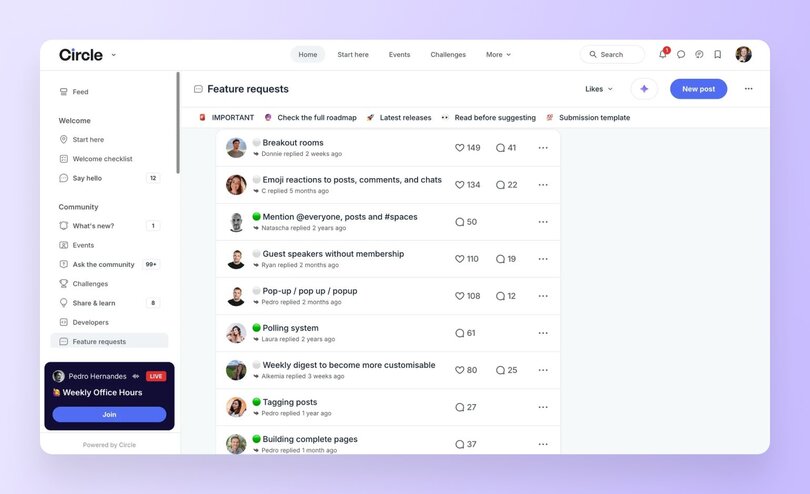
Circle powers these wins
At Circle, we’ve seen it again, and again: our data and reports (like the 2025 Community Trends Report) show that when companies invest in a brand community, they unlock measurable, lasting impact. We found that:
- Events drive deeper engagement. Our built-in event hosting tools help you create regular touchpoints—from weekly AMAs to monthly challenges—that keep members coming back.
- Built-in affiliate programs amplify advocacy. Circle's native affiliate tracking makes it easy for your biggest fans to become brand ambassadors, turning word-of-mouth into measurable revenue growth while reducing your acquisition costs.
- Custom spaces foster authentic connection. Unlike social media's algorithm chaos, Circle's organized discussion spaces let you create focused conversations around shared interests, ensuring quality engagement over vanity metrics.
- Community-led courses encourage learning. Courses with peer-support and communities surrounding them drive 3x higher completion rates than other online courses—helping you educate your customers on product initiatives.
- Analytics reveal what drives loyalty. Circle's community insights show you exactly which content, events, and member interactions drive the most value, so you can double down on what works and optimize your community ROI.
- Mobile apps keep communities accessible. With Circle's branded mobile experience, your community stays top-of-mind, creating the consistent touchpoints that build lasting relationships—the antidote to an AI-dominated digital world.
People crave connection. And a well-built community becomes a self-perpetuating engine of growth, insight, and loyalty—and Circle is designed to power every part of it.
What makes a great brand community
Not all communities are created equal. The most successful brand communities share five core characteristics:
- Clear purpose: Members know why the space exists and what they’ll get out of it.
- Ongoing interaction: It’s not a one-way channel. Members talk to each other, not just to the brand.
- Shared values: There's a “we're in this together” feel. They’re more than just customers, but people aligned with something bigger.
- Consistency: Rituals, regular content drops, and engagement moments keep things fresh.
- Empowerment: Members feel ownership. They co-create the community’s culture.
6 tactics from successful brand communities
Here's how real businesses put these principles into practice to drive measurable results:
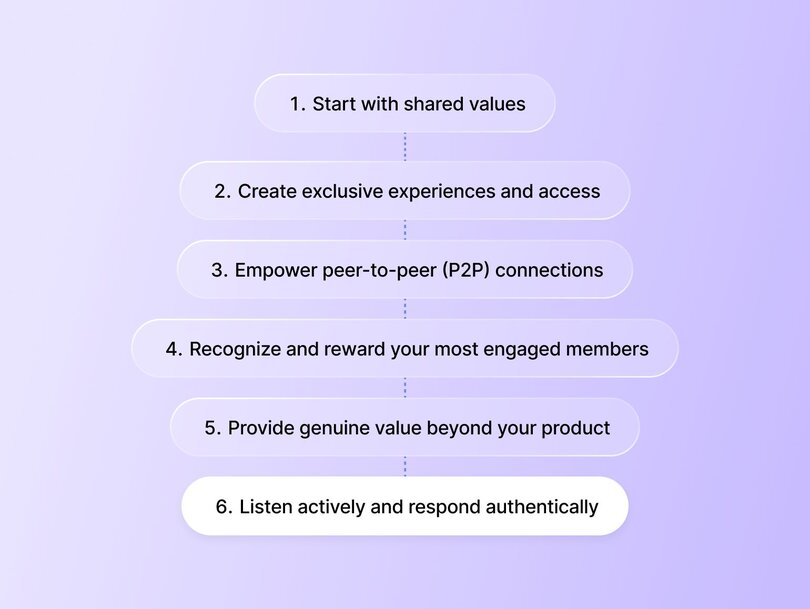
1. Start with shared values
The strongest communities are built around why you exist, not what you sell. Think: sustainability, creativity, wellness, autonomy, empowerment, efficiency. Whatever it is, make it clear, and make it real.
Ali Abdaal built his $5M/year business, Part-Time YouTuber Academy, by leading with what his audience really needed. Instead of asking “What can I sell?” he asked, “What problem can I help solve?”
When he reached out to his audience, the answer wasn’t editing tips or thumbnails; it was imposter syndrome, burnout, and self-doubt. These were deeply human challenges that a course alone couldn’t fix.

“The whole method here is lead with value. Give people something tangible. At the end, make an offer for the next tier: like, by the way, would you like to buy a course?”
—Ali Abdaal, founder of PTYA
Instead of just offering a course on how to build a YouTube business, Ali built a community rooted in support, shared ambition, and encouragement. That shift reframed everything. People didn’t just enroll; they connected, stayed, enrolled deeper, and grew.
2. Create exclusive experiences and access
Give your community something the public can’t get. That could mean early product access, behind-the-scenes sneak peeks, or invite-only events.
Whoggga, a no-BS, relationship-first networking community for business owners founded by Gregg Pajak and Adam Holtzer, took this even further. From day one, Whoggga decided membership isn’t open to just anyone; every applicant goes through a multi-step vetting process to ensure they’re aligned in values and genuinely committed to building meaningful connections. That way, members are connecting with real business owners who are looking for real relationships.
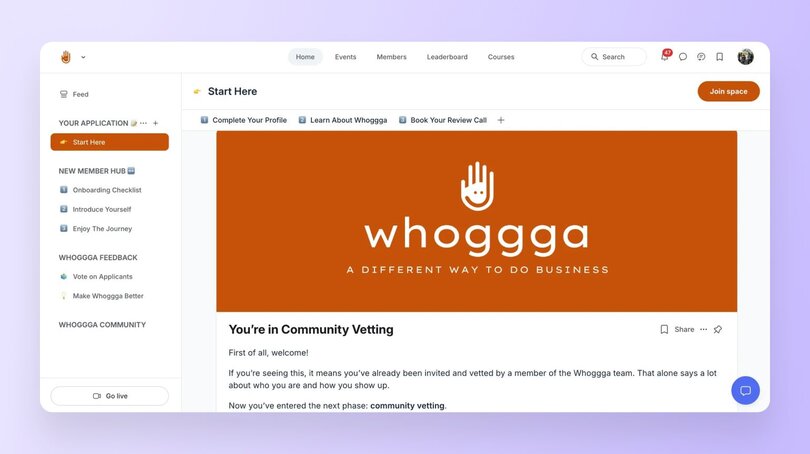
"The first question [when launching our community] was are we going to vet individuals? And the answer was, absolutely, yes. Just because your credit card clears doesn't mean you can join Whoggga."
—Gregg Pajak, co-founder of Whooggga
With 24/7 access to a tight-knit group of vetted peers, a branded mobile app for seamless interaction, and no-pressure networking designed around real relationships, Whoggga has created an environment where members feel like insiders, not just attendees.
That being said, not every community needs a vetting process. We see many Circle communities offering exclusive experiences through VIP forums or expert AMA sessions to keep members engaged and appreciated. This creates a similar sense of exclusivity and intention with the content and members you're connecting with.
3. Empower peer-to-peer (P2P) connections
A brand community isn’t a fan club. It’s a network. The best communities facilitate peer-to-peer connection through interest groups, discussions, local meetups, or even mentorship programs. When members bond with each other, the brand becomes indispensable.
For example, Pat Flynn saw his SPI community grow and monetize when he made the decision to bet on connecting like-minded people.
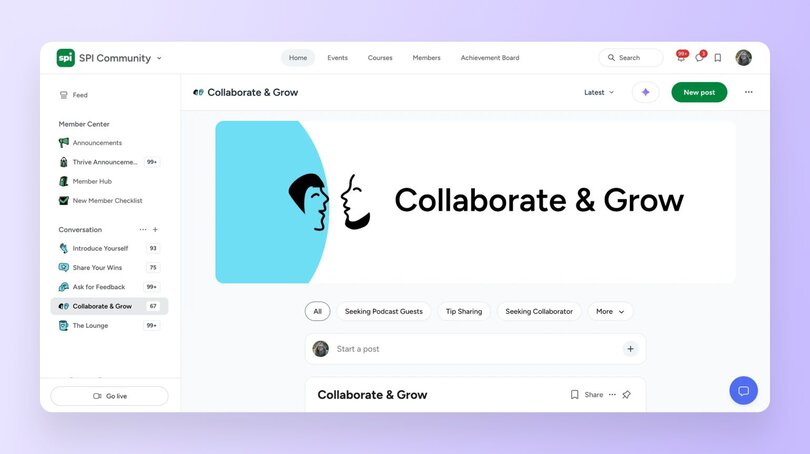
"SPI is the premier place to not just get the right information, but also surround yourself with the right people."
—Pat Flynn, founder of SPI
By creating a space where entrepreneurs could learn and lean on each other, SPI became more than ebooks and courses; it became a place for belonging and connecting too. Flynn saw member engagement soar, retention improve, and SPI unlocked new, recurring revenue through memberships.
4. Recognize and reward your most engaged members
From digital badges to feature shoutouts, public recognition goes a long way. When you reward your most engaged members, you not only encourage them to keep showing up, you show others what’s possible, too. Some communities spotlight members in newsletters or let them co-create content. Whatever you choose, make recognition a part of your community strategy, not a one-off.
Take a look at The Upside, a premium community for independent consultants and coaches. Erin Halper, the founder, builds recognition into the fabric of the community through intentionally crafted rituals.
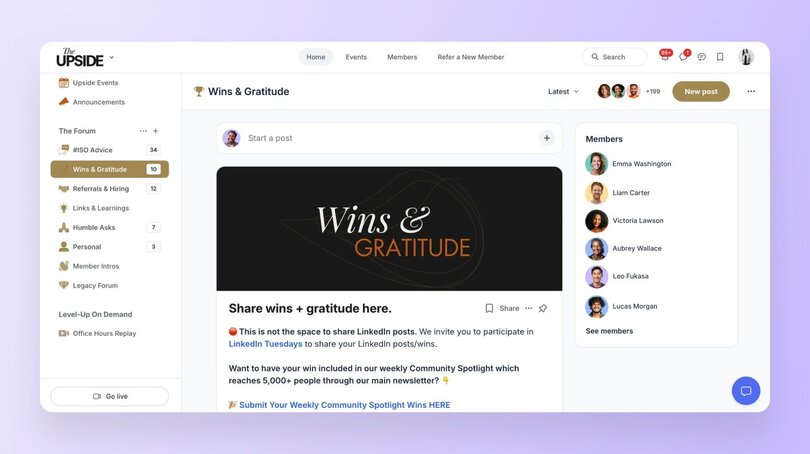
“Every community has something like wins, brags, or successes. Ours is specifically and intentionally ‘Wins & Gratitude’. Adding the word ‘gratitude’ is so important because it encourages our members to recognize and celebrate the role other members have played in their success.”
—Erin Halper, founder of The Upside
This isn’t just cheerleading, it’s strategic recognition. Highlighting member wins, encouraging public acknowledgment, and setting norms around gratitude make engagement visible. This inspires others to participate. It builds a culture where meaningful contributions are recognized, appreciated, and repeated.
5. Provide genuine value beyond your product
The most successful brand communities don't just support your product—they enhance your members' entire journey toward their goals.
Anna Tyrie's English Like A Native community demonstrates this perfectly. While her courses teach language skills, her community provides something courses alone can't: real practice opportunities, peer connections, and ongoing motivation.
Her Conversation Club became the heart of the community—a scheduled space where students practice speaking with each other in real-time. This wasn't just an add-on feature; it solved a core problem that traditional language courses miss: students need actual conversation practice, not just lessons.
The results speak for themselves. The Conversation Club became Anna's biggest community driver, bringing members back regularly to check schedules and discover other offerings. Even better, students started forming real friendships and meeting up in person—turning a digital learning experience into genuine human connections.
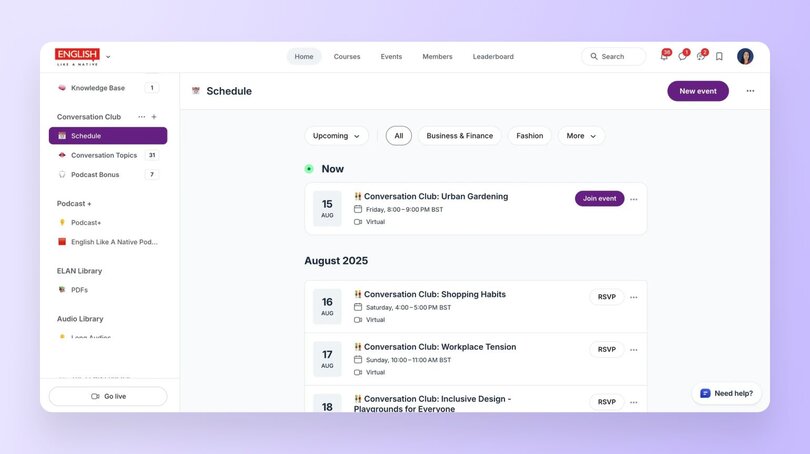
“Bringing the Conversation Club in has been the best thing I’ve done: it brings them into the community to check the schedule, and then they see all the other things on offer.”
—Anna Tyrie, founder of English Like a Native
The lesson: identify what your customers need to succeed that goes beyond your core product, then build community features that deliver exactly that.
6. Listen actively and respond authentically
Make feedback loops part of the DNA of your brand community. When members suggest ideas, thank them. When issues arise, address them openly. When content resonates, double down. Listening builds trust. Trust builds community. Community builds growth.
This is exactly what founder Felippe Nardi did with Inside The Show, a community that helps people become better presenters. Nardi understood that live presenting often leads to unexpected hiccups and questions, so the team created one-on-one support through a dedicated “Ask Felippe and The Team” space.
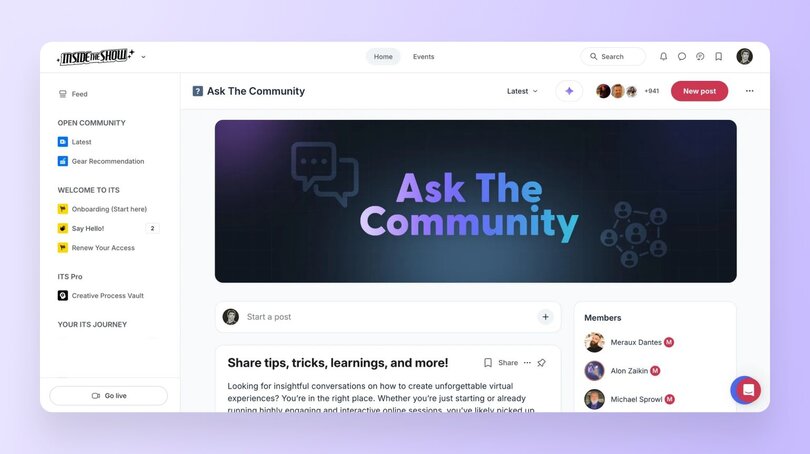
“I want them to feel that they are part of a community, that they are being answered, that we are acknowledging their presence.”
—Felippe Nardi, founder of Inside the Show
This open-door support system reassures members they’ll never be stuck alone. It shows that responsive, accessible help isn’t just a perk of the community, it’s a cornerstone of its trust and growth.
How to build your brand community (a step-by-step guide)
Building a thriving brand community doesn’t happen overnight, but with intention, consistency, and the right structure, you can turn customers into advocates and passive users into active buyers.
Now, let’s get into the steps of how to actually build your brand community:
Step 1: Define your strategy and audience
Every successful community starts with a clear intention. Ask yourself:
- Why are we building this?
- Is your goal to deepen loyalty?
- Improve retention?
- Create advocacy or gather feedback?
Often, it’s a blend, but getting specific early on will guide every decision ahead.
Next, define who the community is for.
- What does your ideal member care about?
- What problem are they solving, and why would they want to connect with others on the same journey? A strong community serves both brand and member needs.
- Where do these two things overlap? This is your foundation. Set it thoughtfully, and everything else becomes easier.
Pull from marketing personas, research documents, or customer journey maps to ground your community design in real data. This ensures you’re not guessing at who your members are, but intentionally building around what you already know about them.
⚡️Pro tip: If you’re lacking customer data, interview a handful of power users or customers before building. Ask where they hang out online, what they wish existed, and what community means to them. You can also use sites like SparkToro as proxies for audience demographics.
Step 2: Choose your platform and set it up
Once you know your “why” and your “who,” it’s time to choose where your community will live. This isn’t just a tech decision, it’s a strategic one.
Look for a platform that can evolve with your community’s needs. For example, Circle is designed specifically for creators, brands, and organizations building intentional communities. It offers flexible structure (spaces, groups, courses), custom branding options, built-in analytics, and easy tools for onboarding and moderation.
The platform you choose should make it easy to create a welcoming environment and allow you to scale as you grow. Maybe you’ll want to enable your community to evolve from casual conversations into structured courses and resource libraries. Or maybe you want to start with a single discussion space and expand into subgroups, tiered memberships, or events as your audience grows.
As your needs become more complex—like bringing on a community or program manager, introducing stronger analytics and workflows, or outsourcing routine support to an AI agent—you’ll want a platform that can grow with intention and flexibility right alongside you.
⚡️ Pro tip: Keep it simple at first. This not only makes your launch smoother, but also helps members focus on what matters most. You can always layer in more once your community finds its rhythm.
Step 3: Create your content and engagement plan
Now comes the heart of the experience: what your members actually do once they arrive. Start by planning content for your first few weeks. Think: welcome posts, guided icebreakers, and exclusive resources that provide immediate value.
Next, establish rituals and actions. Weekly discussions, monthly challenges, AMAs, or live sessions help build rhythm and momentum. Rituals aren’t just for engagement; they give your community its personality.
You want your rituals and programming to be guided by core concepts and principles that help shape what “ideal” member actions look like.
For example, if one of your brand’s core principles is innovation, your rituals might include monthly “idea jams” where members co-create solutions, or you could spotlight sessions highlighting inventive member projects. It’s more than just sharing posts in your community space. You want to create activities that facilitate how you want members to act and connect.
⚡️ Pro tip: Give new members a “first 5” checklist: 5 actions to take when they join (introduce yourself, download a template, attend your first live event, etc.). It gives them momentum and helps you track early engagement.
Step 4: Launch with a beta group
With strategy and structure in place, you’re ready to go live, but don’t launch to everyone at once. Start with a beta group: a smaller, curated set of members who can offer feedback, shape culture, and feel a sense of ownership from day one.
Be transparent. Set clear expectations about what’s happening and what’s coming next. Celebrate small wins, amplify early voices, and be responsive to what’s working (or not).
The early days are about momentum, not perfection. Your job is to listen, learn, and create an environment people want to return to.
⚡️ Pro tip: Use a “founding member” badge or shoutout to reward early adopters. That recognition builds loyalty and turns members into ambassadors faster than any paid campaign.
Step 5: Scale and optimize based on data
Once your community has found its footing, it’s time to refine and grow. Use analytics (like those built into Circle) to track what’s resonating.
- What content drives engagement?
- Which members are most active?
- Where does drop-off occur?
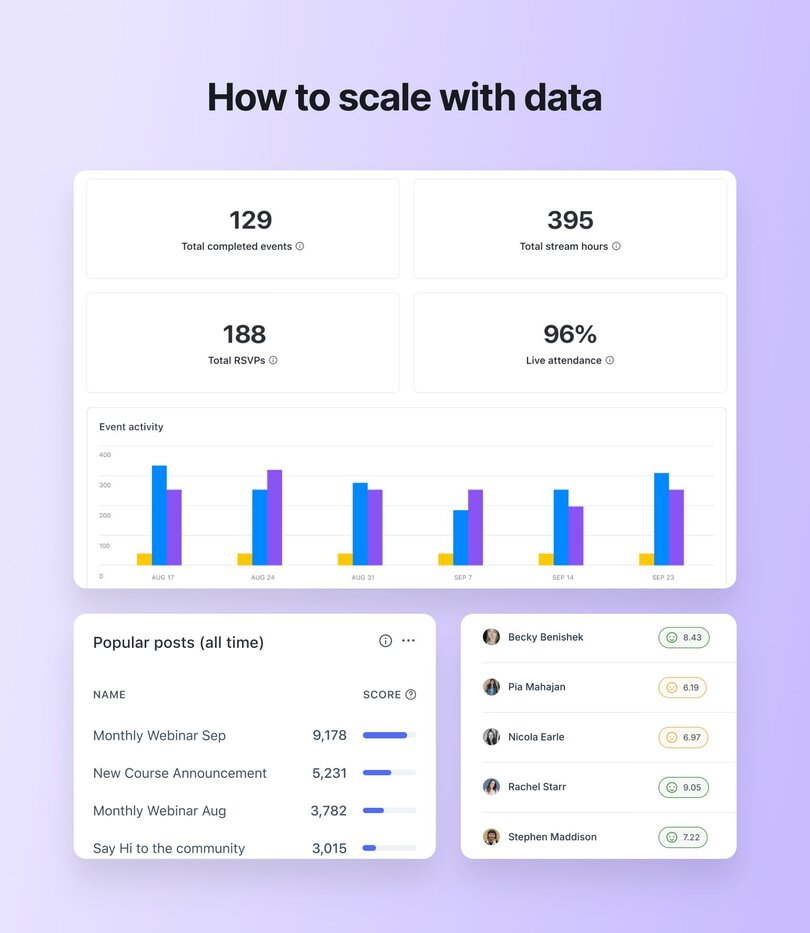
As your community matures, consider segmenting by cohorts, interests, behaviors, or member types. This allows for more personalized experiences without fragmenting the core. And don’t overlook re-engagement. Lapsed members aren’t lost causes. A well-timed nudge, spotlight, or personal invite can bring them back into the fold.
⚡️ Pro tip: Track engagement by depth, not just volume. A smaller group that shows up weekly and contributes consistently is far more valuable than thousands of passive lurkers. Optimize for connection, not just reach.
A brand community is your competitive edge
In a world where attention is scarce and trust is hard-won, community isn’t a nice-to-have. It’s your competitive edge. If you're ready to build a brand community that drives real loyalty, advocacy, and sales, Circle is here to help you make it happen. When people feel like they’re part of something, something they’ve helped shape, they stick around longer, spend more, and become your loudest advocates.
FAQs about brand communities
What is a brand community?
A brand community is a group of people who gather around shared values, interests, and experiences—with your brand at the center. Platforms like Circle make it easy to structure these connections through spaces for discussion, events, and courses, helping members move from casual interest to active engagement.
How is a brand community different from a brand tribe?
A tribe is built purely on identity, while a brand community combines identity with intentional engagement fostered by the brand itself. With the right tools, you can create rituals, events, and content that keep members connected in a way that scales with your business.
How do brand communities increase customer loyalty?
They create belonging, deliver ongoing value, and give customers a place to be heard. When members feel recognized and connected, they stick around longer and invest more deeply. Circle communities, for example, often use recognition rituals, live sessions, and peer-to-peer groups to strengthen these bonds—leading to higher retention and lifetime value.
How do brand communities reduce acquisition costs?
Engaged members often become your best advocates, bringing in new customers through referrals and user-generated content. Some Circle communities formalize this with affiliate programs or ambassador groups, turning organic enthusiasm into a measurable growth channel.
Can a small brand build a community on a budget?
Absolutely. In fact, smaller communities often feel more intimate and powerful. Starting with just a few spaces, recurring discussions, and one or two live events can go a long way. Circle’s flexibility allows brands to begin simply and layer in more features—like courses or branded apps—as the community grows.
How do I measure ROI from a community?
The impact shows up in retention, adoption, referrals, and support cost reduction. With Circle, you can connect these outcomes directly to engagement data, member behavior, and even revenue through built-in payments and analytics—making it easier to show the business value of community.
How do I launch if I’m starting from zero?
Start with a small beta group of your best customers, invite them into a focused space, and host a kickoff event to build early momentum. Circle makes this manageable by letting you set up simple welcome flows, track feedback, and expand into more structured programs once the foundation is strong.